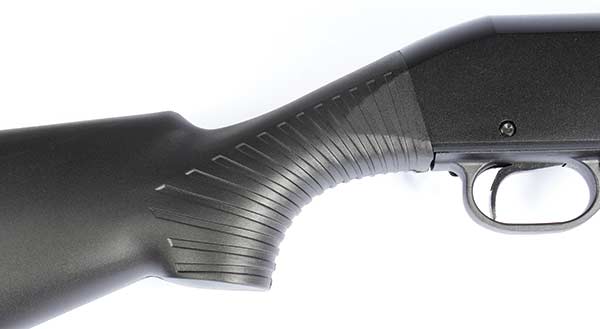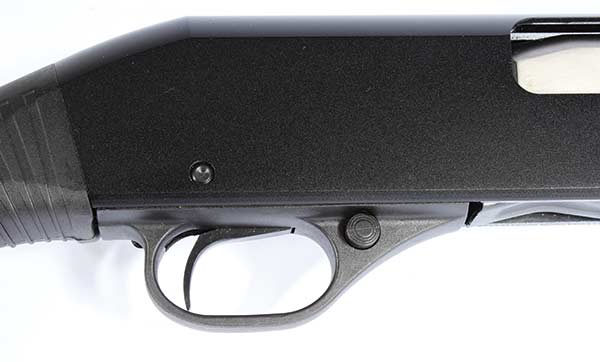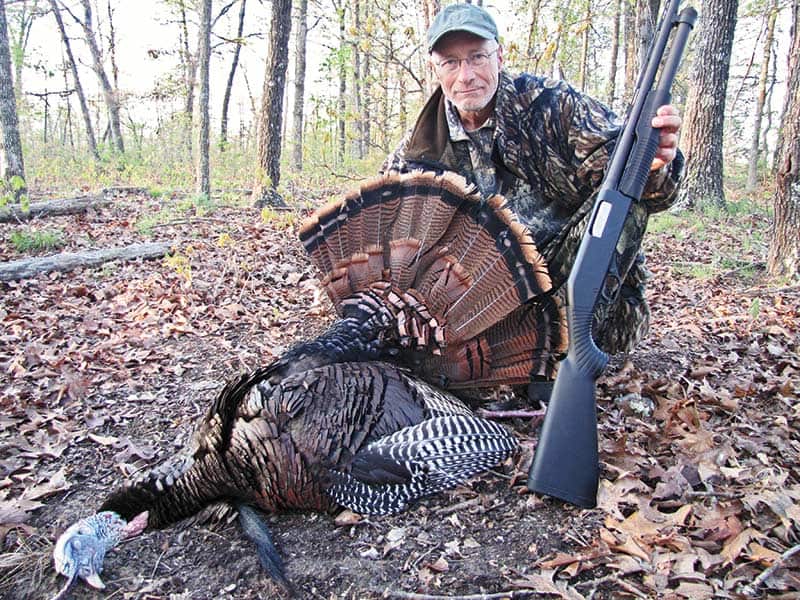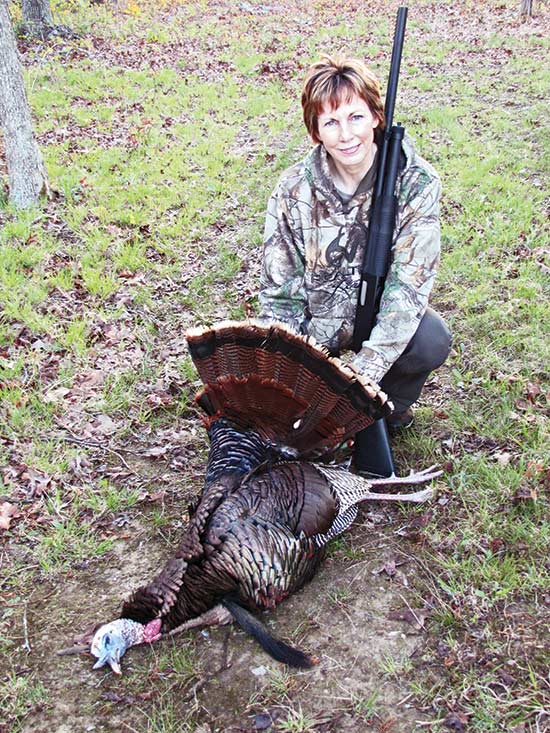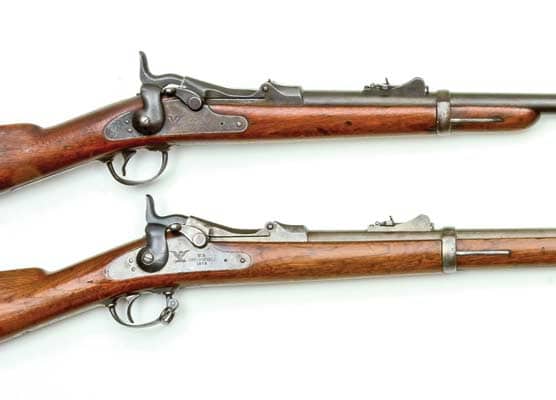Turkey-Bustin' 20
The Stevens Model 320 Pump
proved to be just the ticket for toms
Spring is a wonderful time of year. After a few cold, snowy months of the winter doldrums, rejuvenation is most welcome. The grass is turning green, trees are budding, crappie and white bass are biting, morels are ready to harvest. And turkeys are starting to gobble.
I live smack dab in the middle of prime turkey hunting—and have all of my life. For some, spring turkey hunting is akin to religion. It’s serious business. It also accounts for considerable sleep deprivation, but the rewards are immeasurable. Plus, the table fare is out of this world.
For the first 20 years or so of our marriage, Karen never took an interest in turkey hunting, as she valued a good morning’s sleep. But somewhere along the line, things changed. She’s now become addicted and has taken a number of big gobblers with one of my 3-inch 12-gauge guns. Here in Missouri we are only allowed shotguns and archery, no rifles or handguns.
Karen really enjoys shooting those big toms, but she doesn’t necessarily enjoy getting her teeth jarred loose with the recoil. So, just a few weeks before turkey season she hit me with this: “I’d like a gun that doesn’t kick so much.”
Of course, I didn’t tell her, but I didn’t want to spend a boatload of money on a gun she’ll only use once a year—and for one or two shots at most. But before you call me a tightwad, allow me to explain a couple things with a simple question. Have you ever examined shotguns used by long-time, experienced turkey hunters? Their shotguns are tools—and so is mine.
These scatterguns often get a coat of camo paint simply to hide the many scratches and blemishes they’ve accumulated over the years. Occasionally, they get used almost as a boat paddle. They get dragged through the brush, thrown in and out of vehicles and boats and are generally abused. The criteria for a good one? It has to throw an acceptable pattern and function reliably.
For Karen, the recoil concern was real. With the modern advances in shotgun ammunition, I thought a 20 gauge would be the right choice. After all, most of the birds we call in are shot inside of 40 yards. There are several good choices, but we settled on a Stevens Model 320 Field Grade.
This rugged, 3-inch chambered pump boasts the same features as its 12-gauge counterpart—dual slide bars, a rotary bolt and a 5-round tubular magazine. It’s basic, utilitarian and budget-friendly—just what turkey hunters need.
It fits Karen perfectly. The stock is a tad longer than 12-1/2 inches. She can shoulder the gun properly even when wearing her camo jacket. The gun is all matte black, including the synthetic stock and forearm. The dull finish does not reflect glare, a vital attribute for turkey hunters. Both the pistol grip and forearm have wide serrations, providing a non-slip grasp. A gold bead sits on the front of the vent-ribbed, 26-inch barrel. A large serrated safety is located in front of the triggerguard. It comes with installed sling swivel studs. This feature comes in handy as many turkey hunters use a sling to keep both hands free when moving through heavy cover and packing out big birds.
The Right Sight
The only thing I added was a Truglo Gobble-Dot fiber-optic sight, which fits any rib width with adhesive. The front, bright-red portion fits up against the gold bead. Two green fiber-optic dots sit further down the rib, wherever you deem appropriate. When you look down the barrel, the red dot aligns easily between the two green ones. Like many other field-grade gun, this one came with the front bead only—nothing in the way of a rear sight.
That may not be a problem for most folks, but let me tell you, it is for me. I have killed far more turkeys than I deserve, but there’s a flip side to this fact. I’ve also missed far more than my share. In fact, I sometimes manage to astonish myself, missing a gobbler well inside the effective range of the 12-gauge turkey load.
You’d think a gobbler inside of 40 yards should never get away, but it happens. And if you hunt long enough, it’ll happen to you. There are a few birds missed every year when hunters simply shoot beyond the effective range of their gun/load/choke. I’ve been guilty of this on occasion. But for me personally, the biggest culprit is raising my head off the stock in order to get a better view of the bird.
Oh, sure, I’ve still been able to see the front bead when I’ve put it on the tom’s neck and pulled the trigger. The problem is my head was off the stock to the point I was no longer looking down the rib and the barrel. I was actually pointing over and above the bird’s head. But with the Truglo sight, you can look directly down the rib, place the red dot in between the two green ones and be certain to be on target. No more excuses!
The 3rd Degree
In my search for ammunition, I procured some 20-gauge Federal Premium 3-inch, 1-5/16-ounce, copper-plated No. 4 shot in their high velocity turkey load. As I was sharing turkey-hunting stories with Federal’s J. J. Reich, he suggested I try their new 20-gauge 3rd Degree turkey load, too. This innovative offering features a tiered 3-stage 1-7/16-ounce payload, employing 40 percent No. 5 Premium lead, 20 percent No. 6 Flitestopper lead and 40 percent No. 7 Heavyweight.
The concept is to deliver a more forgiving pattern at closer ranges, while still providing long-range performance. The entire combo’s effectiveness is maximized by Federal’s Flightcontrol wad, which opens from the rear and stays with the shot column for a longer interval than does a conventional wad. This all sounded mighty high-tech to a country boy, but I agreed to try it. I wanted to see if practical applications matched the theory.
Range and Field
A quick trip to the range was in order so we could pattern both loads. Karen quickly showed she could handle the 7-1/2-pound Model 320 without any problems. The recoil did not intimidate her with either load. We patterned the loads at 30 yards and were impressed with how many pellets landed in the head and neck zone. Karen was able to rack the slide effortlessly for a second shot if needed. The gun balanced and handled well, and Karen was already convinced she could notch her tag with it.
One of the few times I witness my wife enthusiastically up before 4 a.m. is turkey season. We deployed our decoys in the predawn darkness while hearing three gobblers sound off on their roost nearby. Shortly after daylight, on opening morning, three big toms came in but for some unknown reason refused to step inside effective range. We passed up several jakes an hour or so later, hoping the mature birds would return. They did not. Unfortunately, the second morning was a repeat of the first: three mature birds came in but not close enough to launch a payload of pellets. So close—yet so far away!
It was a little frustrating for Karen, but that’s all part of turkey hunting. Our third morning was indeed the charm. For whatever reason, those same three big gobblers came in early—and in range. Karen carefully aimed at the strutting tom, and when he stuck his head up looking for a hen, she dropped him at 28 yards. She was one happy girl! Later that same morning, I got lucky with the first turkey I’ve taken with a 20-gauge. Those 3rd Degree loads worked as advertised.
After the hunt, Karen was satisfied she’d found the right combination of shotgun and load for her spring gobbler obsession.
For younger hunters and women who don’t enjoy harsh recoil, the Stevens Model 320 Field Grade is a nice option. With a price of $238, you won’t deplete your kids’ college fund by any means. Heck, I may keep it loaded in the house for home defense! It’s a practical, working-class scattergun at an affordable price. What’s not to like?


